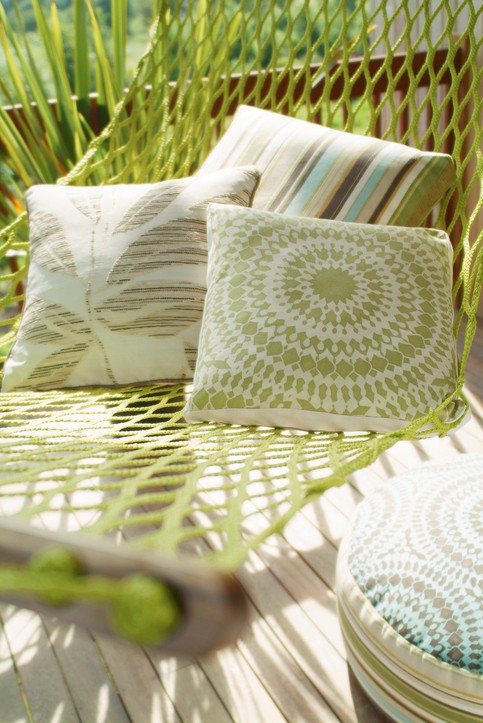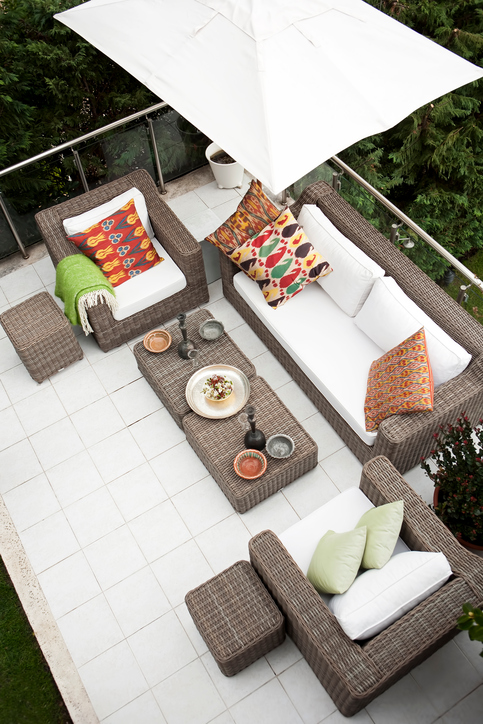With summer’s blazing heat giving its place to a lovely warmth that does not scorch our skin anymore most of us are overwhelmed by the desire to spend more and more time outdoors, enjoying our lovely porches, backyards, balconies or verandas. Now it is the best time to relax outside the home and be creative with your outdoor spaces. If you feel the need to revamp your patio furniture and cushions so that they infuse style and make inviting additions to your outdoor décor, today we will share the best fabrics for cushions to choose from (we have already talked about best outdoor curtain fabrics) so you can turn your outdoor areas into lovely retreats that will not demand much maintenance on your behalf!
What to Consider Before Choosing Fabrics For Outdoor Cushions
Before doing anything else, first consider whether the cushions will be exposed to the elements or not. They do not have to be under direct sunlight to get damaged. Patio cushions and furniture are still subjected to the rough Canadian climate, distinguished by extremes in hot and cold of the outdoors, as well as moisture and winds. With that in mind, we suggest a water-resistant or waterproof fabric for your outdoor cushions and furniture, regardless of its specific placement. That aside, it is best the fabric you select is also fade resistant. This will help prevent the sun and rain from damaging the cushions.
If you long for a reliable solution that will last for many years to come, we say go for designer fabrics, such as Sunbrella, which are perfect for outdoor upholstery and drapery applications. However, there are literally 1000’s of outdoor fabrics to choose from if you want more options to help create a seamless transition between your indoor and outdoor living spaces. The more you understand about the types of fabrics suitable to the outdoors, the more your options will open up.
Tip: Do not only focus on the outer material for your outdoor cushions. Our professional furniture upholsterers suggest you fill your cushions with 100% waterproof filling and cover your pillow inserts with polypropylene covers.
Best Fabrics to Use Outdoors (in General)
If you do not want your outdoor spaces to function solely as summer entertainment areas, but also be suitable for late spring and early autumn get-togethers with friends and family members, you need to take into consideration factors, such as humidity, rain, and weather. In general, the three best fabrics to use outside are:
1. Polyester
It is a strong fabric that has both commercial and industrial uses and comprises a good option to use and wear outside for the following reasons:
-
It resists wrinkling, stretching, and abrasion.
-
It is lightweight.
-
It dries very quickly.
-
It is very easy to clean.
-
It can be resistant to mildew.
-
It is UV resistant.
The drawback with polyester is that it loses much of its strength after prolonged exposure to moisture and UV rays. You will find it in a rich plethora of colours to match your fabric but you can expect the colours to fade over time if under direct sunlight. That being said, it makes a good choice for outdoor cushions, boat covers, canvas covers, upholstery, awnings, sails, tarps, and tents.
2. Acrylic
Acrylic fabrics (100% acrylic) are a superb option for outdoor use (see Sunbrella* brand outdoor fabric) mainly due to their durability, easy maintenance, breathability, mildew and fade resistance, and waterproof properties. They also withstand all sorts of weather, which makes them ideal for sail covers, marine interiors, cushion covers, drapes, fully upholstered pieces, and decorative pillows, among others.
*Sunbrella is 100% solution dyed acrylic. This means that its fibres are pre-dyed in a colour solution and then woven, which allows the colours to stay true for a really long time.
3. Nylon
Nylon and polyester have a lot of the same qualities. Nylon is one of the most versatile fabrics in the textile industry and an exceptionally strong fabric (compared to polyester, nylon has a high strength-to-size ratio). It is no wonder it has numerous indoor and outdoor uses. It also dries quickly and impresses with its high resistance to abrasion. The added elasticity makes it a superb option for upholstery applications while its high tensile strength makes it ideal for heavy fabrics used in home décor.
Overall, nylon is a bit softer than polyester, but equally easy to wash, and somewhat UV- and mildew-resistant. The fact that it does not have the UV resistance of polyester is the reason why many designers do not recommend nylon for outdoor applications unless you are using it on shaded items. However, it is a fabric that will not last as long as polyester outside, despite being a great general-purpose fabric with flexibility and stretch.
Tip: Also made of nylon, ripstop fabrics are a fab alternative to nylon if you need something resistant to ripping and tearing. It comes with an impressive strength-to-weight ratio and is mainly used in kites, high-quality camping equipment, yacht sails, parachutes, banners, and other applications that demand a strong, yet lightweight, fabric use.
Most Used Fabrics for Outdoor Cushions
Cotton Canvas
Traditionally, outdoor weave materials, like canvas, were made with hemp. However, today we tend to use cotton instead. Cotton canvas has several outdoor applications and is relatively inexpensive. The heavy-duty fabric is available in pre-dyed solid prints and colours while it can also be re-dyed easily with fabric paint in case you feel like creating your own fabric design and give your outdoor spaces more of your unique, personal style.
Tip: Although hard-wearing, do not forget to treat cotton canvas fabrics with a protective coating before using them.
Duck Canvas
You may also hear it referred to as duck, duck cloth or cloth duck. Duck canvas is very similar to cotton canvas. The main difference between those two is in the weave; duck canvas has a tighter weave than its cotton counterpart. It is a bit more expensive and slightly smoother too. You can find duck canvas in a wide array of weights but it is more difficult to paint and add your own flair and designs to the material. Overall, duck canvas is a good option for those that want something a little sturdier without having to sacrifice the cottony feel.
Textilene Fabric
Textilene fabric or Textilene mesh is usually used for sun shades, sling seating, and outdoor furniture. It is actually woven polyester with a PVC coating. Besides being waterproof, it has a high resistance to colour fading and mold while it is also flame retardant. It is clearly suited to the outdoors in terms of durability and functionality, as long as you are okay with the polyester feel (it feels a bit like plastic). If you want something more comfortable and softer to the touch, we suggest you do some tests before purchasing the fabric (it is sold by the yard).
Olefin Fibre
It is a synthetic fibre that is also known as polypropylene. Olefin is an excellent option for cushion covers and inserts. Thanks to its strength, high resistance to heat, mold, staining, abrasion, UV rays, and wet weather, and colourfastness, it is a much preferred fabric for both indoor and outdoor uses, from carpet tiles and rugs to draperies, upholstery, floor coverings, and, of course, outdoor cushions, to name just a few.
PVC (Vinyl or Polyvinyl Chloride)
Vinyl is an easy to clean, hardy fabric, whose use started in the 1920’s. Today, it is the second most popular plastic in production. However, the ongoing debate regarding its impact on health and the environment does not leave much room to Eco-conscious homeowners to “play” with its versatility. That aside, vinyl is best to be used to backings or pillows instead of parts of your outdoor cushions due to its distinct plastic feel that makes you sweat in the summertime, and the fact that it can be easily torn if overly stretched.
What Else to Check Besides Fabric For Your Outdoor Cushions
1. The Foam
Although the right outdoor fabric will play the most vital role in the way your outdoor spaces look and feel, it is also important to consider foam, which is also a large part in the life of every cushion that is meant to be used outdoors. Now, you may opt for regular foam (the type you usually find in chair and sofa cushions) or foam that is made specifically for outdoor use.
Regular foam is reasonably priced and easy to find. However, it is not waterproof, which means that it will eventually let water into the cushions as soon as the first rain storms hit. Of course, this means that the fabric of the cushion will collect moisture and mold (unless you are willing to cover the cushions or store them inside when you are not using them).
On the other hand, foam that is made for outdoor use (it lets water run through it) tends to be a bit expensive but is a much better option for outdoor cushions that will inevitably be wet, such as yacht/boat cushions and cushions too large to bring/store inside when the weather gets too cold to sit outside.
2. The Base of the Cushion
Making sure the cushions sit on a woven or slating base (of some sort) that will allow the water to run through them and not sit and mold the bottom of the cushions will save your day. Check whether there is anything solid under the foam; something that the water could sit on. Doing the necessary fixes will help the cushion dry after rain.
Maintenance Tips
Depending on your preference for style and comfort, there are plenty of outdoor fabric options for your cushions to choose from. No matter what you decide to opt for, though, remember that you can help extend the life of your cushions with regular maintenance. So, wipe them after rain to prevent mildew and mold from developing, and wash them once in a month or so to remove surface dirt, even when the weather is not intense or rainy.
If you feel overwhelmed by the plethora of options available and need some help sorting things out, just give us a call or contact us. Our expert staff will be able to help you make the best pick after taking into consideration your budget, lifestyle, and outdoor living space.
Enjoy!


